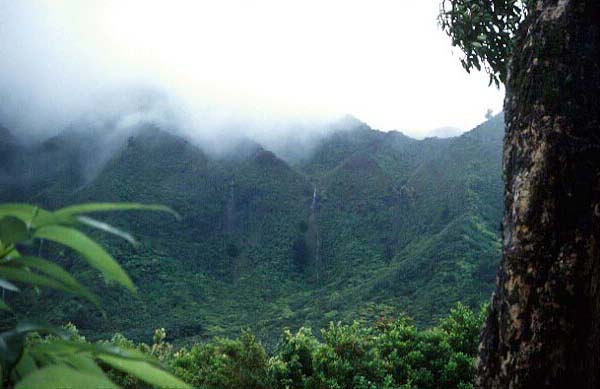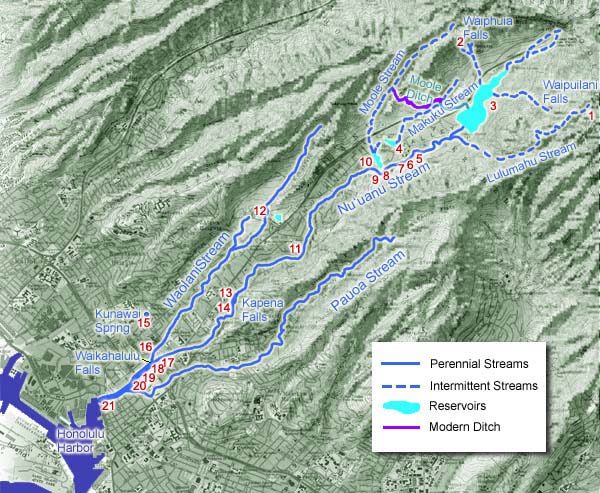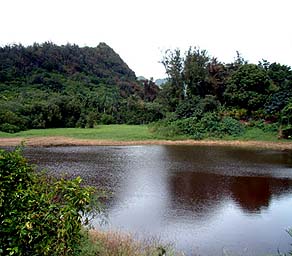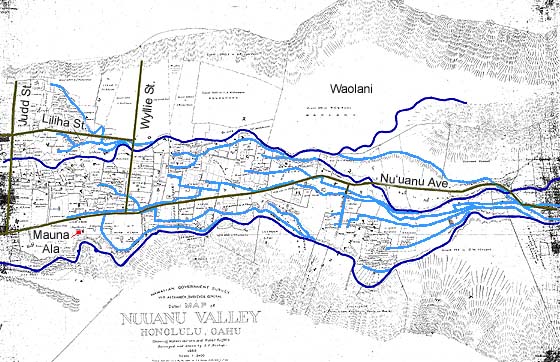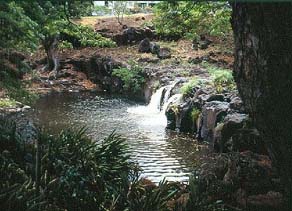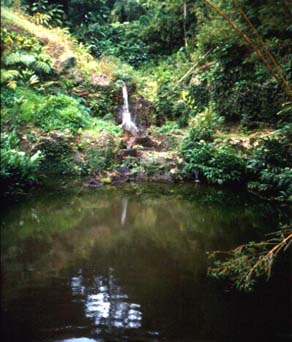 |
 |
 |
|||||||||||||||||||||
|
|
|
|
|
|
|
|
|
||||||||||||||||
|
|
|||||||||||||||||||||||
| |
|
|
|
|
|
"The life on these islands is about water," Stephen says. "We are the most remote archipelago on the planet. We call it a 'freshwater oasis in the largest saltwater desert.' All around us is sea water." "A lot of people talk about the ahupua‘a running from the mountain to the sea, and we always try to correct them: that’s the path of the water. The actual account, historically, is that the ahupua‘a developed from the sea to the mountains. Because the forests were always considered sacred, and there was a protocol for their use. So as Hawaiian culture evolved and the population grew, people expanded and moved up the valley. "And when you think about it, that’s why there is such protocol on the use of water. If you went above somebody else’s farm to develop a new taro patch, you had to respect the rights of those below you. So we see in the Hawaiian tradition about the use of water, the idea that it’s sacred, it’s a gift of the gods, it comes from the mountains, and each person along the way had a duty to the person below."
|
|
|
|
|
|
| As water flows from the mountains to the sea, so too does this discussion of water in Nu‘uanu. On the Rain page, Stephen explained how the Ko‘olau mountains intercept the trade winds, and in a uniting of Sky and Earth, clouds form and rain is created. Thus the top of Nu‘uanu Valley, with the highest elevations is the wettest. Here the waterfalls of Waipuhia and Waipuilani poured down to feed Nu‘uanu, Mo‘ole, and Waolani streams. But for decades these waters have been first intercepted by a series of reservoirs. The first of these was built by King Kalakaua in the 1880s.
|
|
|
"Kalakaua started some water works projects back here that took water from this upper area," Stephen explains. "There’s a huge pipeline that runs through Kaniakapupu. That pipeline fed a hydroelectric plant down in the area called Reservoir 1, near the O‘ahu Country Club. "That plant supplied hydroelectric power for the lighting of the city of Honolulu. The relationship of this ahupua’a, the water here, and the urbanization of Honolulu began in Kalakaua’s time. "
|
|
|
|
|
|
||
|
"Reservoirs that we know of today are actually part of the WPA Conservation Corps projects in the 1930s," continues Stephen. "During the depression, Roosevelt had a plan to put all the unemployed workers to work. They built the Hoover Dam. They had Conservation Corps work camp here, and there were four reservoirs built. Where the reservoir is now, there once was a basin. "Now we are finding that from ancient times there was a large settlement up here in Nu‘uanu. This land here, in Luakaha and around Kaniakapupu, was known to be agricultural land. This whole area was very fertile, very productive because of a lot of water. Today we call it a 'conservation district' for watershed. In ancient times this was a thriving community, where people planted."
|
||
|
|
||
|
|
An extensive auwai system for taro irrigation occupies the central portion of the valley, drawing off the three streams that descend from above. The history of this system perhaps predates the Battle of Nu‘uanu, but the numerous battles of the late 18th century had, as we learned, left O‘ahu in a shambles. After the Battle of Nu‘uanu, as Kamehameha moved quickly to restore the valley's agriculture, he summoned Ku-ho‘oheihei-pahu (Abner) Paki to rebuild the irrigation works. Carol Silva (1995: 27) writes of Paki that "in three days, he rallied several hundred men to construct the tremendous Nu‘uanu irrigation system which supplies the numerous taro pondfields....This irrigation system is known even today as the Paki auwai."
|
||
|
|
||
|
|
"The auwai still travel through the valley and as far as I know through most of our Home sites," Kalani reflects. "There are three where I live. The main Nu'uanu River and two auwai. And the auwai we used to irrigate the lo‘i. They are still running now. They are protected but many residents do not know this and as the newer residents purchase homes and decide, 'oh, I think I don’t want to bother with this water flowing down, through my yard, I think I’ll cover it up.' "And unfortunately, they do that, and if somebody discovers it, a neighbor, they are informed that they can not fill in the auwai or change it in any fashion. So they usually plank it and cover it. I don’t understand why anyone would want to come up to Nu‘uanu Valley and do that. But we do have people of different backgrounds and ideas. They think water is troublesome. "
|
|
"You can see how these graded waterfalls would have been associated with bathing rituals," Stephen remarks, pointing out the many falls and pools along Nu‘uanu Stream. "You have clues all around us of this being a very sacred area. We know that in Hawaiian culture there were areas reserved for certain practices. Generally, the highest level water--the cleanest water--was reserved for drinking; the next level of water was used for irrigation; the next lower level was used for washing utensils and clothing; and then the next level down was used for bathing. "There was a sequence of uses, very much like you had the terrestrial zones, the wao akua and kula and such. The uses of water were according to certain zones to preserve the quality as it made its way down to the ocean."
|
|
|
|
|
The auwai stop above Judd Street and do not service the coastal plain. In the Pohukaina page, Stephen explained the limestone geology of the coastal plain, and how there were many springs. "Hawaiian culture is based on the concept of ohana, the family," he adds. "In relation to taro, what that meant was that the very earliest taro patches were really probably built around springs, because it would have natural for a family to settle their house lot near a spring where they had fresh water. "There’s evidence of house lots throughout this area. And it’s really, sort of a no-brainer: if you see a house lot there was a spring near by, since there wasn’t a water supply system like we have." Many of these springs probably dried up when big projects diverted water out of the mountains, lowering the water table. The water table was the pressure valve that kept springs going. We will learn more about these events in the Memories chapter.
|
||
|
|
||
|
|
Does the sense of protocol surrounding water survive today? Kalani reflects on the Jackass Ginger pool at Kahuailanawai: "It has become ruined by so much activity from people not from the Nu‘uanu area that frequent the pond. People who go into the forest and hike or do whatever, they leave their rubbish behind. It rains so frequently that the rubbish immediately washes into the stream and clogs it, and thereby makes it dangerous. "So today you do not find many of the residents of Nu‘uanu enjoying the streams as they used to, because there is so much garbage in it now. I know that some of the residents will walk upstream and clear tracks or portions of it as far as they can go and hope that the next homeowner will pick up from there. Many do, and it’s a rewarding job doing it, but the rubbish never seems to stop. "My hope would be that all those who want come up here will say 'Gee, I want to enjoy Nu‘uanu environment,' I hope they take care and do not leave their rubbish behind."
|
|
|
||
|
If water is the life of the land, then there is not enough that can be said about its importance. We will return periodically to touch on issues affecting the streams of Nu‘uanu. But the real importance of the water lies in its use for the production of food. So we turn our attention now to the story of Planting in Nu‘uanu.
|
||
|
|
||
| |
| |
|
|
 |
| Nu‘uanu Home | Map Library | Site Map | Hawaiian Islands Home | Pacific Worlds Home |
|
|
|||
| Copyright 2003 Pacific Worlds & Associates • Usage Policy • Webmaster |
|||
